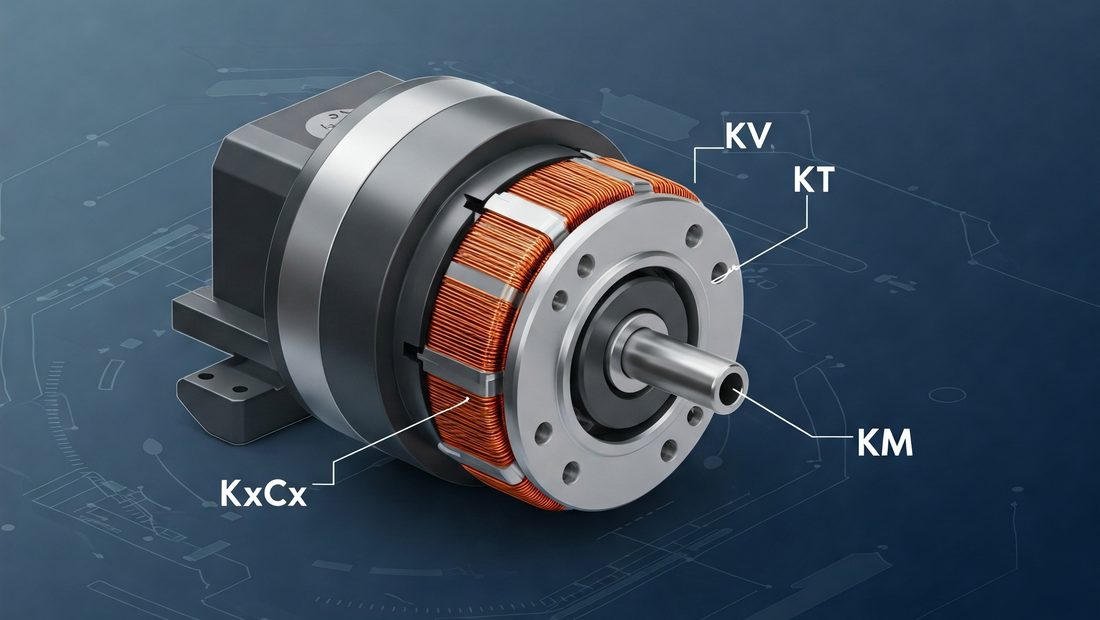If you've spent any time working with BLDC or PMSM motors, you've probably encountered terms like KV, Kt, Ke, and Km. These constants are often thrown around in datasheets, forums, and technical docs, but what do they actually mean—and how do you use them?
KV and Ke constant
The KV constant is commonly used in hobbyist contexts. It is typically given in RPM per Volt, and usually measured line-to-line. For example, a 100KV motor will spin at 100 RPM per applied volt (no load). But this isn't the whole story.
In engineering and industrial applications, the Ke constant (back-EMF constant) is more often used. It relates the back EMF voltage per rad/s of rotor speed, and it's usually specified per phase.
𝐾ₑ = 𝑉ₚₕₐₛₑ / 𝜔

⚡️ What Is “Line-to-Line”?
In a 3-phase motor, there are three windings: A, B, and C. Line-to-line voltage is the voltage measured between any two motor wires, like A and B. It's what you measure between two terminals with an oscilloscope or multimeter.
So, if you spin the motor and probe between phase A and B, the peak-to-peak back-EMF you get is a line-to-line voltage.
⚡️ What Is “Per Phase”?
“Per phase” means the voltage generated across a single winding, i.e., from a motor terminal to the neutral point (Y-connection center). This is how Ke is typically defined in textbooks and industrial applications. It’s what you would get if you could measure from phase A to the internal neutral point of the motor.
Since most motors are Y-connected (star) internally, and you can’t access the neutral point directly, this is usually not measurable directly, but it’s a useful theoretical concept.
Kt — Torque Constant
𝐾ₜ tells you how much torque you get per ampere of current. It's usually expressed in Nm/A.
For BLDC motors:
𝐾ₜ = 𝐾ₑ ⋅ (3 / 2) ← for sinusoidal commutation
𝐾ₜ = (3 / 2) ⋅ (1 / √3) ⋅ (60 / 2π) ⋅ (1 / 𝐾ᵥ)
𝐾ₜ = 8.27 / 𝐾ᵥ (𝐾ₜ in Nm/A, 𝐾ᵥ in rpm/V)
For a DC motor, it's simpler:
𝜏 = 𝐾ₜ ⋅ 𝐼ₐ (𝐼ₐ = armature current)
For a 3-phase motor:
𝜏 = 𝐾ₜ ⋅ 𝐼_q (𝐼_q = q-axis current)
Km - motor constant
The Problem with Relying Solely on KV
Motors with low KV usually have many turns of thin wire, which leads to higher winding resistance. While this design provides higher torque per ampere, it also demands higher voltages to push sufficient current through that resistance. Conversely, high KV motors have fewer turns of thicker wire, resulting in lower resistance but requiring more current to generate the same torque.
In systems where voltage or current is limited—due to constraints from motor drivers, power supplies, or thermal limits—these trade-offs become crucial. Therefore, selecting a motor based only on KV or is often insufficient.
Use the Motor Constant (Km) for Fair Comparison
A more effective way to compare motors is by using the motor constant , which considers both torque output and resistive losses:
This metric provides a clearer picture of how efficiently a motor can produce torque relative to the heat generated by resistive losses. Motors with higher values are generally better suited for high-performance applications where power efficiency and thermal management are critical.
The motor constant represents a motor’s capability to convert electrical power into mechanical power effectively:
where is the resistive power loss and is the line-to-line winding resistance.
Summary
The Motor Constant Km is the best metric to size a motor, as it defines the torque-power relationship. The units are Nm/sqrt(watt). The Torque Constant defines the torque-current relationship of a motor and is in Nm/amp. The motor and torque constants are related by the formula Km = Kt(trap)/sqrt(R), where R is the phase-to-phase resistance of the winding. Two motors with the same Km can have dramatically different torque constants and Torque-Speed curves due to the wire gauge used and the number of turns. Kt is useful when calculating the required current based on the required torque. Km is useful when comparing motors and in calculating temperature rise based on dissipated power.
The motor torque constant (Kt) is a measure of the relationship between the torque output of a brushless DC motor (BLDC) and the current flowing through it. It is typically measured in units of newton-meters per ampere (Nm/A) or ounce-inches per ampere (oz-in/A). The Kt of a BLDC motor is determined by the number of windings in the stator, the number of magnets in the rotor, and the size and shape of the magnets.
A higher Kt value means that the motor can generate more torque for a given current, which is desirable for applications that require high-torque operation, such as UAVs carrying heavy payloads or performing maneuvers that require a lot of power.
Learn more
- https://build-its-inprogress.blogspot.com/2016/01/motor-characterization-for-small.html
- https://www.roboticstomorrow.com/article/2020/04/understanding-the-motor-constant-in-dc-motor-sizing/15146/

